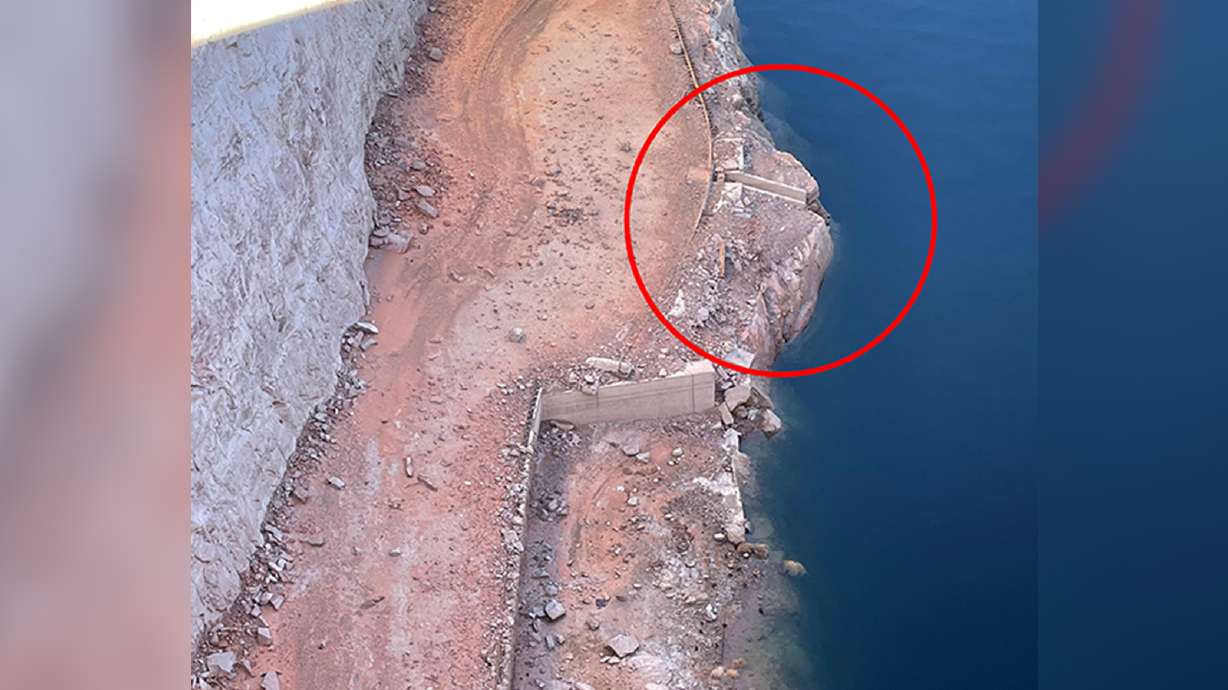Estimated read time: 3-4 minutes
This archived news story is available only for your personal, non-commercial use. Information in the story may be outdated or superseded by additional information. Reading or replaying the story in its archived form does not constitute a republication of the story.
Editor's note: This article is a part of a series reviewing Utah and U.S. history for KSL.com's Historic section.
LAKE POWELL — The declining water levels at Lake Powell, caused by the West's ongoing drought, have unearthed another piece of history that had been submerged for over five decades.
Foundations of an old concrete plant used in the 1960s to help complete the construction of the Glen Canyon Dam — located just south of the Utah-Arizona border — started to reappear in recent weeks, according to the Bureau of Reclamation. Lake Powell was just 3 years old when the foundations were last visible.
"These foundations we are seeing today have not been above water since 1966," the agency wrote in a Facebook post Tuesday.
The plant dates back to just before the construction of the Glen Canyon Dam began. In April 1956, then-President Dwight D. Eisenhower signed a bill that authorized a system of dams in the Upper Colorado River Basin. This triggered the start of what would become the 710-foot Glen Canyon Dam and Lake Powell.
"Wednesday, April 11, will be recorded into the history book as one of the great days for the Upper Colorado River states," stated one report of the announcement, printed in an April 12, 1956, edition of the Roosevelt Standard.
According to the report, Eisenhower told reporters that the bill represented his belief of how important the Colorado River was to people.
"It recognizes what water is getting to be our most valuable resource," Eisenhower said after he signed it, 65 years ago.
Construction began with a dynamite blast in October that year, according to the bureau. Eisenhower triggered the blast himself, using a telegraph key from Washington, D.C. that set up the explosion in northern Arizona.
Between then and June 1960, crews set up a concrete plant that would pour the concrete to construct the massive dam. This is the piece of history now visible near the dam today.
"The area was used to haul freshly mixed concrete from the plant to the dam using a system of cable and industrial-size buckets, allowing workers to position and place the concrete on the site," bureau officials wrote Tuesday.
The first bucket of concrete was poured on June 17, 1960. It went into a 137-foot excavated area that would become the dam's foundation. The concrete plant remained an important piece of the dam construction over the next three years, up until the completion of the dam on Sept. 13, 1963.

The reservoir began to fill shortly after. It would take 17 years for it to fill up to an elevation of 3,700 feet above sea level. Along the way, it submerged the concrete plant foundations, estimated at 3,525 feet, in 1966, per the federal agency.
But Utah's ongoing drought — especially, the megadrought that researchers say is the worst the region has experienced in 1,200 years — has depleted Lake Powell's levels. The Bureau of Reclamation reports Lake Powell is now about 25% full and just shy of 395 feet deep at the dam.

The decline already exposed original canyons and landscapes that had been covered by water since 1963, prior to the recent discovery of the remains of the concrete plant.
Lake Powell isn't alone in this, either. Last year, reminders of what used to be the town of Rockport reappeared as Rockport Reservoir, in Summit County, dried up.
Low water levels in Hyrum Reservoir last year also led to the discovery of over a dozen old cars. Park officials said that many of the cars were likely dumped into the Cache County reservoir in the 1950s.









